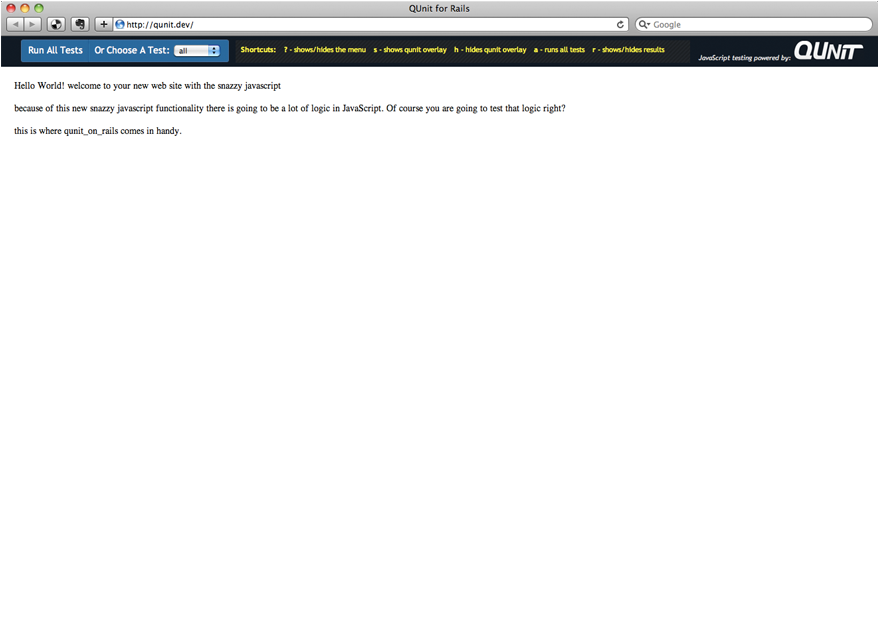QunitForRails
QUnit for Rails provides an easy way to run JavaScript integration testing against production rendered HTML using the QUnit testing framework. QUnit for Rails simply adds an overlay menu at the top of an app's pages, allowing developers to run JavaScript tests and view the results right in the browser.
To read more about QUnit: http://docs.jquery.com/QUnit
The source for this plugin is located on Github: http://github.com/mkrisher/qunit_for_rails/
The plugin can be installed using:
script/plugin install [email protected]:mkrisher/qunit_for_rails.git
Details
QUnit for Rails provides an easy way for developers to write JavaScript tests and run those tests against HTML output in the browser. QUnit for Rails does not run via the command line, it is run in the browser against the real HTML output.
QUnit for Rails provides some necessary JavaScript and CSS files and places them in your app's public directory. These files simply create the overlay menu that gets added to your pages. The plugin also provides the latest QUnit file. In case you ever want to change the version of QUnit, you would simply replace the file in your public/javascript directory.
The overlay provides a number of things. First, all your JavaScript tests are stored in /public/javascript/tests. Any JavaScript test added to the directory will appear in a dropdown in the overlay. Simply selecting a test from the dropdown runs it against the current page. Or there is an option to run all tests against a page.
In much the same way Rails unit testing and functional testing work, you could easily create a JavaScript test for each controller and action of your app.
During the plugin install process, the tests directory is created and an example test file is included. Follow the test file's formatting to create additional tests.
The plugin also provides some handy keypress functionality. For example, hiding the overlay you simply press 'shift+h'. All keypress options are shown by press 'shift+?'.
The QUnit overlay looks like this in the browser:
Running a test pushes the page down and reveals the test results:
Requirements
The QUnit for Rails plugin requires jQuery at this time. You can include jQuery easily by adding to the head of your document layout:
<script type="text/javascript" src="http://www.google.com/jsapi"></script>
<script type="text/javascript">
google.load("jquery", "1.3.2");
</script>
Usage
To include the QUnit testing overlay on your page simply add
<%= include_qunit %> to the head of your document layout.
If you would like to include qunit_for_rails but not have it show on the top
of the page automatically, you can hide it on load using:
<%= include_qunit({:autohide => true}) %>.
After adding the <%= include_qunit %> to the head of your document layout,
you simply need to add some test files to the
/public/javascript/tests directory.
The tests are written in JSON and follow a pattern such as:
var localtests = {
test_another_example : function()
{
module("Module Example Tests");
test("simple passing example", function()
{
var value = "foo";
equals( "foo", value, "We expect value to be foo" );
});
}
};
$().extend(tests, localtests);
Copyright (c) 2009 Michael Krisher, released under the MIT license

